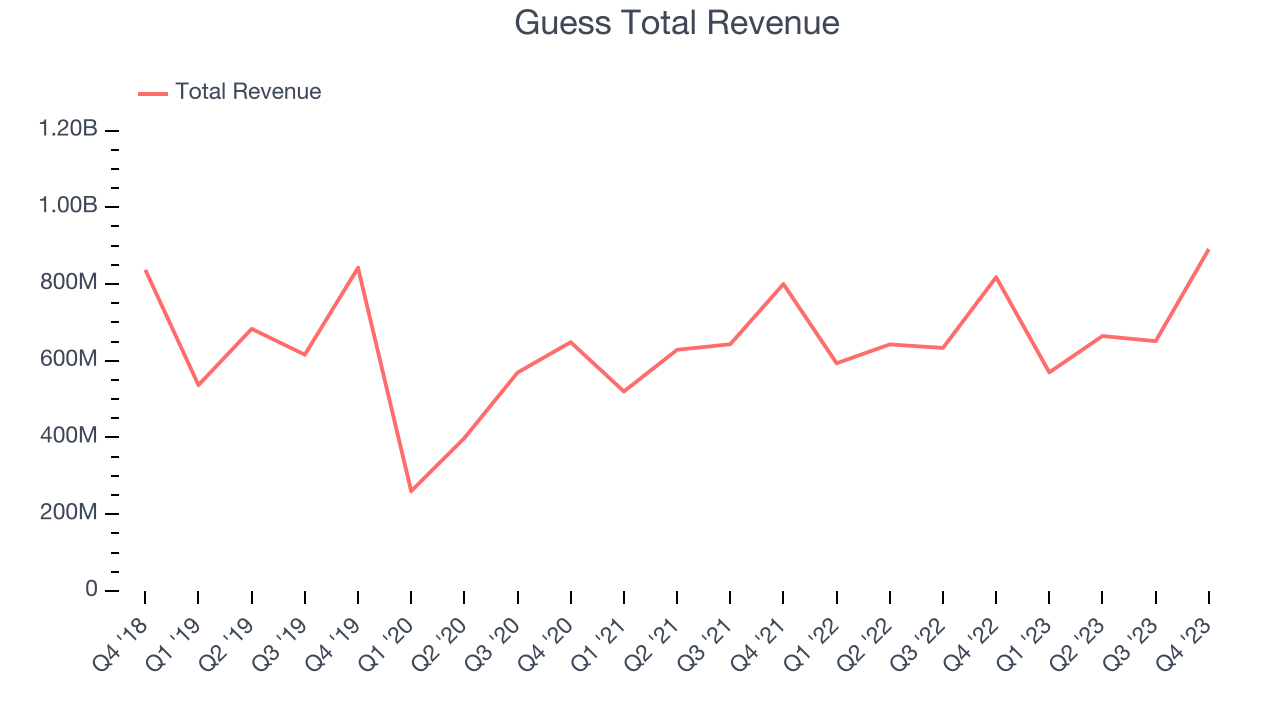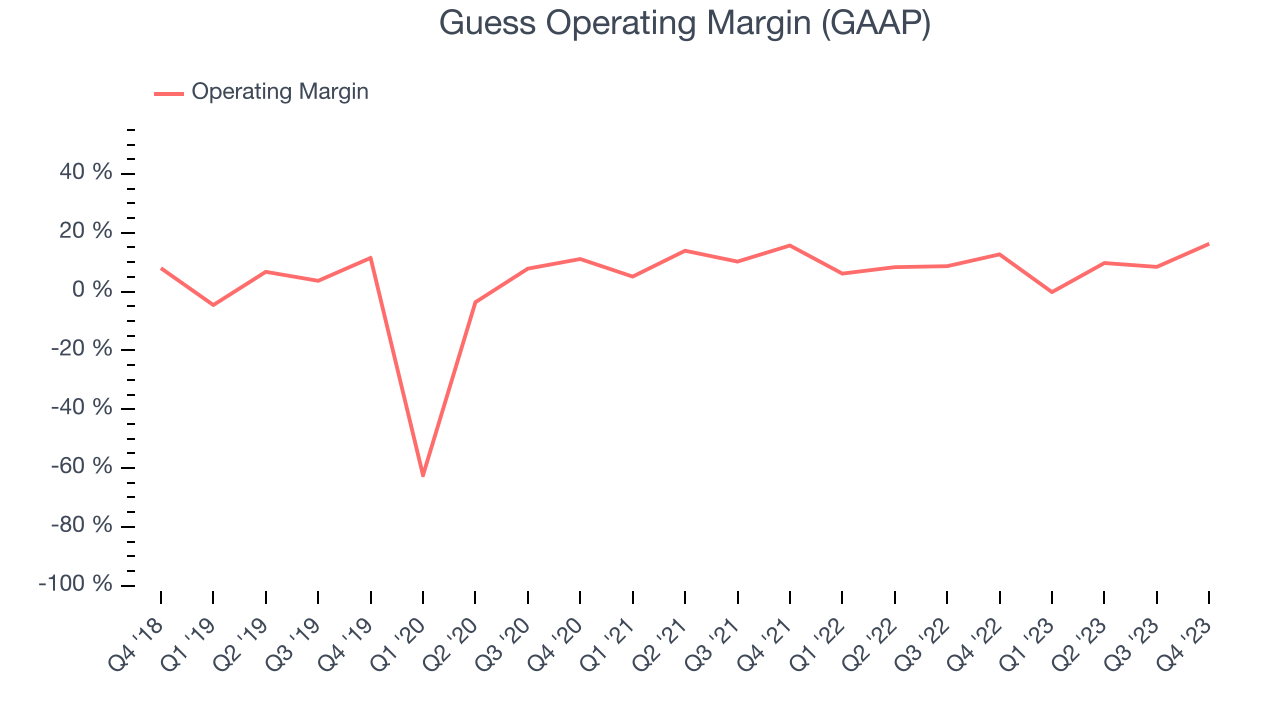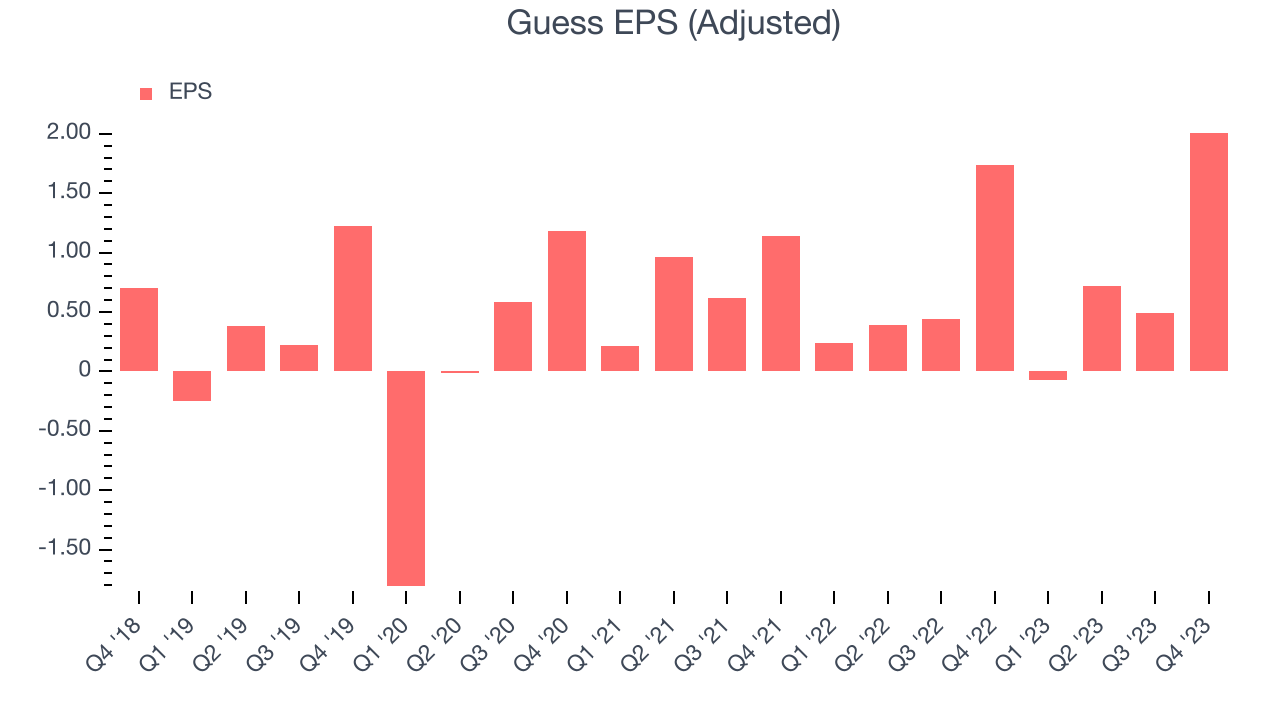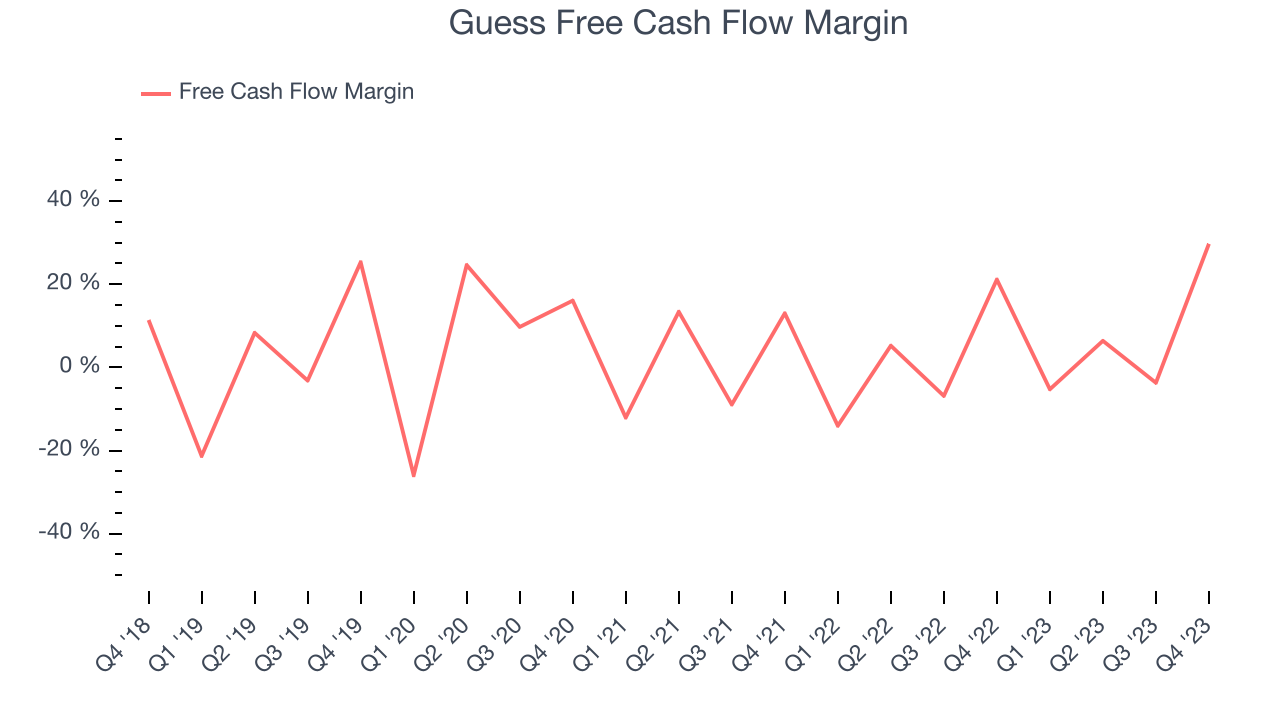Contemporary clothing brand Guess (NYSE:GES) reported Q4 CY2023 results beating Wall Street analysts' expectations, with revenue up 9% year on year to $891.1 million. It made a non-GAAP profit of $2.01 per share, improving from its profit of $1.74 per share in the same quarter last year.
Guess (GES) Q4 CY2023 Highlights:
- Revenue: $891.1 million vs analyst estimates of $854.6 million (4.3% beat)
- EPS (non-GAAP): $2.01 vs analyst estimates of $1.57 (27.9% beat)
- EPS (non-GAAP) Guidance for Q1 CY2024 is -$0.39 at the midpoint, below analyst estimates of -$0.02
- Gross Margin (GAAP): 45.4%, up from 44.2% in the same quarter last year
- Free Cash Flow of $264.9 million is up from -$24.07 million in the previous quarter
- Market Capitalization: $1.35 billion
Flexing the iconic upside-down triangle logo with a question mark, Guess (NYSE:GES) is a global fashion brand known for its trendy clothing, accessories, and denim wear.
Guess was started by the Marciano brothers who sought to redefine denim with stonewashed, slim-fitting jeans that featured their distinctive triangular logo on the back pocket. Their designs quickly gained popularity as the Guess image became more prominent in the fashion world, and today, Guess is known for its youthful and fashionable clothing, accessories, and fragrance lines.
Guess's innovative marketing campaigns and iconic black-and-white advertisements contributed to the brand's success by appealing to a brand-conscious, fashion-conscious, and trend-savvy consumer base. Guess also formed strategic partnerships with celebrities like A$AP Rocky, Gigi Hadid, and Hailey Baldwin to grow its mainstream presence.
Guess generates its revenues from direct-to-consumer sales, which come from its brick-and-mortar locations and e-commerce platform, and wholesale distribution, licensing, and royalty agreements. The company’s revenue-driving strategies are to elevate its brand relevance through marketing and product quality.
Apparel, Accessories and Luxury Goods
Within apparel and accessories, not only do styles change more frequently today than decades past as fads travel through social media and the internet but consumers are also shifting the way they buy their goods, favoring omnichannel and e-commerce experiences. Some apparel, accessories, and luxury goods companies have made concerted efforts to adapt while those who are slower to move may fall behind.
Guess’s main competitors are Zara (owned by Inditex, OTCMKTS:IDEXF), H&M (OTCMKTS:HNNMY), ASOS (OTCMKTS:ASOMY), and private company Forever 21.Sales Growth
A company’s long-term performance can give signals about its business quality. Any business can put up a good quarter or two, but many enduring ones muster years of growth. Guess's annualized revenue growth rate of 1.2% over the last five years was weak for a consumer discretionary business.  Within consumer discretionary, a long-term historical view may miss a company riding a successful new product or emerging trend. That's why we also follow short-term performance. Guess's annualized revenue growth of 3.5% over the last two years is above its five-year trend, suggesting some bright spots.
Within consumer discretionary, a long-term historical view may miss a company riding a successful new product or emerging trend. That's why we also follow short-term performance. Guess's annualized revenue growth of 3.5% over the last two years is above its five-year trend, suggesting some bright spots.
This quarter, Guess reported solid year-on-year revenue growth of 9%, and its $891.1 million of revenue outperformed Wall Street's estimates by 4.3%. Looking ahead, Wall Street expects sales to grow 1.7% over the next 12 months, a deceleration from this quarter.
Operating Margin
Operating margin is an important measure of profitability. It’s the portion of revenue left after accounting for all core expenses–everything from the cost of goods sold to advertising and wages. Operating margin is also useful for comparing profitability across companies with different levels of debt and tax rates because it excludes interest and taxes.
Guess was profitable over the last two years but held back by its large expense base. It's demonstrated mediocre profitability for a consumer discretionary business, producing an average operating margin of 9.4%.
This quarter, Guess generated an operating profit margin of 16.3%, up 3.6 percentage points year on year.
Over the next 12 months, Wall Street expects Guess to maintain its LTM operating margin of 9.5%.EPS
Analyzing long-term revenue trends tells us about a company's historical growth, but the long-term change in its earnings per share (EPS) points to the profitability and efficiency of that growth–for example, a company could inflate its sales through excessive spending on advertising and promotions. 
Over the last five years, Guess's EPS grew 228%, translating into an astounding 26.8% compounded annual growth rate. This performance is materially higher than its 1.2% annualized revenue growth over the same period. There are a few reasons for this, and understanding why can shed light on its fundamentals. Guess's operating margin has expanded 8.3 percentage points over the last five years while its share count has shrunk 16.3%. Improving profitability and share buybacks are positive signs as they juice EPS growth relative to revenue growth.
In Q4, Guess reported EPS at $2.01, up from $1.74 in the same quarter a year ago. This print beat analysts' estimates by 27.9%. Over the next 12 months, Wall Street expects Guess to perform poorly. Analysts are projecting its LTM EPS of $3.15 to shrink by 6.8% to $2.94.
Cash Is King
Although earnings are undoubtedly valuable for assessing company performance, we believe cash is king because you can't use accounting profits to pay the bills.
Over the last two years, Guess has shown mediocre cash profitability, putting it in a pinch as it gives the company limited opportunities to reinvest, pay down debt, or return capital to shareholders. Its free cash flow margin has averaged 6.1%, subpar for a consumer discretionary business.

Guess's free cash flow came in at $264.9 million in Q4, equivalent to a 29.7% margin and up 53.3% year on year.
Return on Invested Capital (ROIC)
EPS and free cash flow tell us whether a company was profitable while growing revenue. But was it capital-efficient? A company’s ROIC explains this by showing how much operating profit a company makes compared to how much money the business raised (debt and equity).
Guess's five-year average return on invested capital was 10.2%, somewhat low compared to the best consumer discretionary companies that pump out 25%+. Its returns suggest it historically did a subpar job investing in profitable business initiatives.
The trend in its ROIC, however, is often what surprises the market and drives the stock price. Over the last two years, Guess's ROIC averaged 14 percentage point increases each year. This is a good sign and we hope the company can continue to improving.
Key Takeaways from Guess's Q4 Results
We were impressed by how significantly Guess blew past analysts' EPS expectations this quarter. We were also excited its revenue and operating margin outperformed Wall Street's estimates. On the other hand, its full-year earnings guidance fell short of Wall Street's estimates, but we note its revenue outlook was strong.
During the earnings release, the company declared a special dividend of $2.25 per share and a quarterly dividend of $0.30 per share.
Zooming out, we think this was still a good quarter, showing that the company is staying on track. The stock is up 8.3% after reporting and currently trades at $28.09 per share.
Is Now The Time?
Guess may have had a favorable quarter, but investors should also consider its valuation and business qualities when assessing the investment opportunity.
We cheer for all companies serving consumers, but in the case of Guess, we'll be cheering from the sidelines. Its revenue growth has been weak over the last five years, but at least growth is expected to increase in the short term. And while its EPS growth over the last five years has been fantastic, the downside is its projected EPS for the next year is lacking. On top of that, its relatively low ROIC suggests it has historically struggled to find compelling business opportunities.
Guess's price-to-earnings ratio based on the next 12 months is 8.8x. While the price is reasonable and there are some things to like about Guess, we think there are better opportunities elsewhere in the market right now.
Wall Street analysts covering the company had a one-year price target of $27.55 per share right before these results (compared to the current share price of $28.09).
To get the best start with StockStory, check out our most recent stock picks, and then sign up for our earnings alerts by adding companies to your watchlist here. We typically have the quarterly earnings results analyzed within seconds of the data being released, and especially for companies reporting pre-market, this often gives investors the chance to react to the results before the market has fully absorbed the information.
